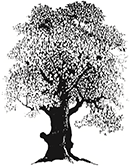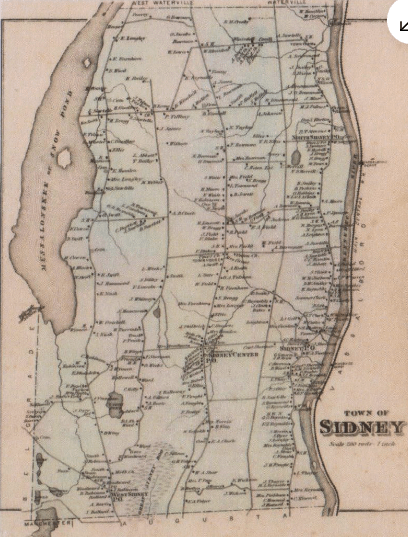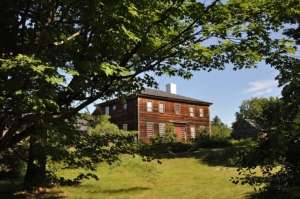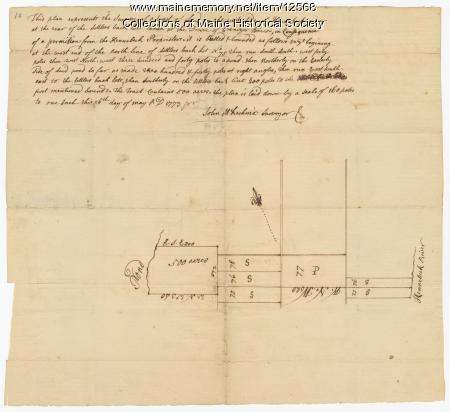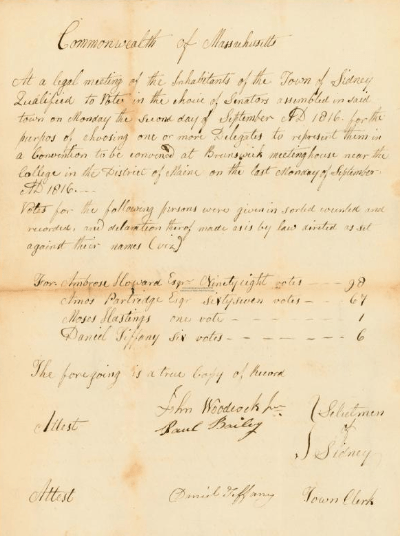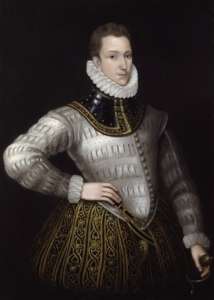LETTERS: Laura Jones will represent the area with reason, honesty and kindness
/0 Comments/in Letters to the Editor, Sidney, Vassalboro/by Website Editor To the editor:
To the editor:
Up for vote in the Maine Legislature this November are 186 seats. I am casting my ballot for Laura Jones to represent the Sidney/Vassalboro communities.
Being a volunteer driver for Laura Jones, I have seen how she actively listens to citizen concerns and how she answers questions with reason and fact.
Born and raised in Vassalboro, Laura’s lifelong experiences with local people and places give her insight into our needs and concerns.
Having served in the Air Force for 25 years, Laura brings to us a unique skill set in understanding local, state, county, federal and international issues – all in perspective.
For Laura, community matters and through her volunteer work with many community groups and her postings on her Facebook page and her YouTube channel (Laura Jones Community Matters), she keeps community informed and up to date on events, meetings, important dates. And, she shares her tech skills with those who need help.
Laura Jones will represent the Sidney/Vassalboro area with reason, honesty and kindness.
Priscilla Doel
Vassalboro
Up and down the Kennebec Valley: Sidney settlers: Lovejoys & Marshes
/0 Comments/in Local History, Sidney, Up and Down the Kennebec Valley/by Mary Growby Mary Grow
Part III
(See Part I here, and Part II here.)
Previous articles in this series have mentioned two other early Sidney families who intermarried with Bacons and Faughts, the Lovejoys and Marshes. This article will provide more information about both.
The first Lovejoy in Sidney is named Abial (in the on-line source Find a Grave and in Henry Kingsbury’s Kennebec County history) or Abiel (in the on-line source minerdescent and in Alice Hammond’s 1992 bicentennial history of Sidney), and is known as Captain Lovejoy and Squire Lovejoy. His second son and namesake also gets both spellings, more commonly Abial. Your writer will try to minimize confusion by using the senior Lovejoy’s titles.
Lovejoy was called “Captain” based on his Massachusetts military service. Minerdescent says he acquired the title “Esquire” when he was appointed a Justice of the Peace in 1781.
Kingsbury listed Esquire Abial Lovejoy and John Marsh as two other 1763 grantees of land from the Kennebec Proprietors (with Levi Powers, whose house on the National Register of Historic Places was described last week).
* * * * * *
Hammond’s history includes a 1991 summary Lovejoy family history that she credits to descendants Betty Bennett and Anita Lovejoy. It also includes the 1892 Kennebec Journal article (referenced in previous articles in this series) that mentions the Lovejoys.
The newspaper writer included two generations, “old Squire Lovejoy, the old slave holder” (Dec. 16, 1731 – July 4, 1811); and “probably his son,” Abial Lovejoy (Feb. 8, 1764 – Nov. 3, 1858).
Captain Lovejoy was born in Andover, Massachusetts, and married Mary Brown on Dec. 14, 1758, in Charlestown, Massachusetts (which one source says was her birthplace).
Mary Brown was born March 29, 1734 (Minerdescent), or July 19, 1741 (most sources), and died Jan. 19, 1812. She and her husband had two, seven, eight or 14 children, depending on the source.
Minerdescent lists seven sons and seven daughters, born between Aug. 8, 1759, and Oct. 1, 1785. The two oldest, Nathaniel (named after his maternal grandfather, Nathaniel Brown) and Polly, were born in Charlestown; the next 11 (including Abial, Jr.) in Pownalborough, Maine; and the youngest, Phebe, who married Ebenezer Morse (mentioned in the Aug. 8 article on the Bacon family), in the western part of Vassalboro that became Sidney.
(Find a Grave, usually a reliable source, names seven children born between Aug. 8, 1759, and Oct. 31, 1780, and lists birthplaces, after the first two in Charlestown, in Vassalboro, Waterville or Sidney – no mention of Pownalborough. The names and dates duplicate the longer minerdescent list.)
Minerdescent, citing older sources, describes Captain Lovejoy’s career in Pownalborough (now Dresden), a town farther down the Kennebec River that was incorporated in 1760.
This source says he first came to Maine, specifically Fort Halifax, with British troops from Massachusetts in 1755. By 1758 he was a captain, headquartered at Pownalborough. Hammond wrote that he served with the British in Maine from 1758 to 1771, and later in the Americans’ Revolutionary Army.
He was also a ship captain out of Charlestown. Various sources say he went to Nova Scotia and the West Indies, and Mary sometimes sailed with him.
On Sept. 29, 1760, Captain Lovejoy bought 35 acres in Pownalborough, and in 1761 he, Mary and their first two children moved there. He became a prominent citizen, owning an inn, building an elaborate house, running a ferry, building ships, buying and selling land and serving as selectman in 1762 and 1764.
Minerdescent calls Mary “handsome” and “cultural,” and says the Lovejoy house was famous for its hospitality. The June 19, 1766, Pownalborough census said Captain Lovejoy “owned a two-story house with 152 squares of glass, one chimney, three rooms with fire places, supported seven persons under sixteen years, and ten persons above sixteen years and he owned one other house one story high with 44 squares of glass and two fireplaces.”
According to minerdescent, on Nov. 12, 1764, Captain Lovejoy and his father-in-law, Nathaniel Brown, “purchased half of a saw mill and adjoining land and a half interest in a dam on a small stream eight miles above Fort Western.” Your writer believes this stream was originally Bog Brook; by 1764 Hastings Brook; and today Goff Brook.
In Vassalboro, too, Captain Lovejoy ran a ferry. Lovejoy’s Ferry, operating in the early 1800s at Riverside, was the southern and earlier of two Kennebec ferries connecting Sidney and Vassalboro (the other was at Getchell’s Corner) that operated into the 20th century.
On-line sources say the oldest Lovejoy son, Nathaniel, born Aug. 8, 1759, took over the ferry, and later Nathaniel’s son Hiram, born Jan. 8, 1805, ran it for a while before moving to Massachusetts.
Minerdescent says the Lovejoys moved to Vassalboro in 1776. The account says they brought their household goods on “flat boats and scows which were towed by row boats”; the boat carrying their best furniture sank in a bad storm.
Their riverside farm remained in the family for several generations. Minerdescent has a long list of Captain Lovejoy’s positions in first Vassalboro and then Sidney, including being elected a selectman in each town. In 1777 he was involved in getting the Massachusetts legislature to expand postal service in Maine.
Captain Lovejoy’s son Abial was the constable who convened Sidney’s first town meeting after Sidney became a separate town on Jan. 30, 1792, Hammond said. In May of that year, Captain Lovejoy was one of the four-man committee chosen to settle accounts with Vassalboro. Later he served on Sidney’s fish committee for more than one term; on the committee that planned the town pound; and in 1798 on the school committee.
Captain Lovejoy served in the Massachusetts legislature for many years, minerdescent says. Your writer found no dates except the early 1780s, when some of his constituents questioned his support of the American cause against Britain.
Minerdescent presented evidence Captain Lovejoy was a staunch patriot. He stirred up opposition to local Tories, and lost $30,000 by giving members of Benedict Arnold’s 1775 expedition to Québec (including Arnold himself) hard money in exchange for paper Continental currency. The currency became worth so little that Captain Lovejoy reportedly wallpapered a room with it.
Captain Lovejoy and Mary died in Sidney in 1811 and 1812. Most sources agree they are buried on the Lovejoy farm, on a slope toward the Kennebec; some call this family graveyard Plain or Old Plain cemetery.
Minerdescent says an infant son or daughter, born and died in 1784, and at least three of the family’s black slaves are also buried there, with all graves marked alike by fieldstones. (When Massachusetts abolished slavery in 1783, Lovejoy offered his slaves their freedom.)
Henry Kingsbury wrote in his Kennebec County history that Old Plain was the oldest cemetery in Sidney and “is thought to hold the remains of over one hundred pioneers.” In 1892, he wrote, “That part of it that has not been plowed shows plainly the forms of many graves and has one shattered slate-stone slab, inscribed ‘Elizabeth Milliner —1785.'” Elizabeth Milliner was the Lovejoys’ housekeeper, minerdescent says, and Lovejoy had her gravestone put up.
Hammond also described the Old Plain cemetery, saying it was on River Road about a quarter mile south of Hastings Brook, “high above the river on a plain that was part of Abiel Lovejoy’s grant.” She, too, estimated 100 people were buried there.
“After many years the land was cultivated so that there are no signs of a cemetery now,” she wrote a century after Kingsbury’s account. But, she said, in 1908 a monument to early settlers was installed.
In another chapter, Hammond wrote that Captain Lovejoy donated land to the town for the Lovejoy cemetery on Densmore (now Dinsmore) road, “in which approximately a hundred of the earliest settlers are buried.” This cemetery is the one your writer visited on July 29; it is not on the bank of the Kennebec.
Kingsbury, minerdescent and other sources tell many stories about Captain Lovejoy and his household. Here is one of your writer’s favorites, paraphrased:
Squire Lovejoy went to the field where some of his farm help, free and slave, had been mowing, bringing them a jug of liquor (he himself was a heavy drinker, even for colonial days, minerdescent says). Dissatisfied with the work, he demanded to know who did it.
The other hands one by one blamed Boston, a slave who had been with the family since Lovejoy bought him in 1758. Well then, said Lovejoy, if Boston did all the work, he can have all the liquor.
Boston is named as one of the slaves buried in the Old Plain cemetery with Squire and Mary Lovejoy.
Minerdescent gives summary information on all 14 Lovejoy children. All married at least once (son Abial, Jr., and daughter Sarah each lost a first spouse and married again), and several spent their entire lives in Sidney.
* * * * * *
John Marsh was another man to whom the Kennebec Proprietors granted land in Sidney in 1763. By Hammond’s account, he was the great-grandson of a John Marsh who emigrated to Salem, Massachusetts, from England around 1634; he and his wife Susannah had six sons, including Samuel (1651 – 1693).
Samuel and his wife Priscilla had a son John (1681 -1727, called John, Sr., in some sources). He and his wife Abigail were parents of six children, including John, Jr. (born Oct. 8, 1718; or 1723). In 1763, John, Jr., came to Sidney with his wife Elizabeth (a widow; maiden name Caryl or Carryl, previous husband Cornelius Claflin, born in 1712, 1716, 1723 or 1725).
Of John Jr., and Elizabeth’s five children, born in Mendon, Massachusetts, one died young and four came to Maine. Two married Sidney men: Abigail (1747) married Dr. James Bacon (as reported two weeks ago), and Hannah (1755 – 1840) married Moses Hastings.
Hammond said the Hastings family owned an adjoining property, and Moses and Hannah inherited the Marsh farm. In 1892, Kingsbury wrote, John’s great-grandson, Lieutenant Gorham K. Hastings, owned the farm, “that has never been out of the possession of the family.”
He added, “The outlines of a block house and stockade are still on the bluff a few feet south” of the Hastings house. Settlers sometimes “took refuge” there fearing attach by Natives, he said.
Hammond wrote that Hastings descendants owned the farm “until Sarah Park Hastings [1857 – 1946] married William Lester Reynolds [1853 – 1926)].” Reynolds descendants owned the property until 2004. (See box.)
John Jr., and Elizabeth’s only son, also John (born in 1751), ended up in the Bangor area. Youngest daughter Mary (born in 1774; this birth date makes her mother’s earlier birth dates unlikely) lived in Paris, Maine.
Hammond wrote that John Marsh Jr., bought his 250 acres on June 8, 1763. He also bought a sawmill on Hastings Brook, which was his south boundary; had a grist mill close to River Road; and was involved with area mill projects.
Several sources say Elizabeth Marsh died June 19 and her widower died Aug. 19, both in 1802, both in Sidney.
Sidney’s Reynolds Forest
Part of John Marsh’s 1763 land grant is now Sidney’s Reynolds Forest, on the west side of West River Road near the Dinsmore Road intersection. This Kennebec Land Trust preserve is recommended for birding, wildflowers and hiking trails along what is now Goff Brook.
Visitors can see the waterfalls that powered the early mills, mill foundations and a cellar-hole in the woods. KLT warns of poison ivy near West River Road.
An online source says in 2004, Sidney resident Bea Reynolds donated the 35-acre Walter W. and Alice B. Reynolds Forest to KLT to honor her parents. In July 2003, a former resident named Leann Diehl added seven adjoining acres of hayfield.
Reynolds Forest, in Sidney.
Main sources
Hammond, Alice, History of Sidney Maine 1792-1992 (1992).
Kingsbury, Henry D., ed., Illustrated History of Kennebec County Maine 1625-1892 (1892).
Websites, miscellaneous.
Western New England University names local students to president’s list
/0 Comments/in School News, Sidney/by Website Editor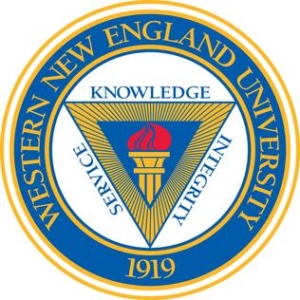 Western New England University (WNE), in Springfield, Massachusetts, recognizes the outstanding academic achievements of two area students named to the president’s list for the Spring 2024 semester.
Western New England University (WNE), in Springfield, Massachusetts, recognizes the outstanding academic achievements of two area students named to the president’s list for the Spring 2024 semester.
They are, Kasen Sirois, of Sidney, who is working toward a BA in communication/media & journalism, and Andrew Mayo, also of Sidney, who is working toward a BSE in civil engineering.
.
Up and down the Kennebec Valley: Sidney early settlers: the Faught family
/0 Comments/in Local History, Sidney, Up and Down the Kennebec Valley/by Mary Growby Mary Grow
The Faughts were another early Sidney family. The first Faught your writer came across was Marlborough Packard Faught, a name that sounded refreshingly unusual; but she soon found that the Faughts, like the Bacons, enjoyed repeating more common names – Frederick, Jacob, Samuel – through generations.
Alice Hammond wrote in her history of Sidney that the Faughts “were active in community affairs on both sides of the Kennebec River [in Vassalboro and Sidney].”
She gave no details from early history, nor did Alma Pierce Robbins, in her Vassalboro history (Sidney was part of Vassalboro until it became a separate town on Jan. 30, 1792). Henry Kingsbury, in his history of Kennebec County, included no Faughts on his lists of town officials.
(Hammond mentioned two 1915 events: George Faught, a Boston tailor, died that year and left money to the town “for the benefit of the school at or near Bacon’s Corner”; and on July 31, Florence Faught was chosen first Grand Matron of White Rose Chapter, No. 174, of the Order of the Eastern Star.
(Hammond said in 1992 the school fund had $3,000, from which interest could be used for students at Sidney’s only elementary school, James H. Bean School, on Middle Road. White Rose Chapter is no longer on the Maine list of Eastern Star chapters.)
Kingsbury named three Faughts, Anthony, Frederick and Jacob, as early settlers.
If your writer has found the right family, these were sons of a German named Philip Faught and his unidentified wife. Kingsbury wrote that Philip emigrated to Boston in 1751 and moved to Dresden, on the Kennebec below Augusta, in 1756.
Philip Faught’s sons are listed on Familysearch as Philip (1744 – 1772 or later); Frederick (1746 – 1814); Jacob (1750 – 1830) and Anthony (1752 – 1830). This site says all four Faught boys were born in Germany, despite Anthony’s birthdate the year after the family supposedly came to America.
* * * * * *
Philip, born in 1744, married a woman named Hannah and was identified as “of Vassalboro” at his death sometime after 1772. Your writer found no other information.
* * * * * *
Frederick, born around 1746, “came to America with the family and settled on the Kennebec in Sidney, where he spent the rest of his life,” Kingsbury wrote. (Presumably Frederick moved to Sidney later in his life, not in 1751 when he was about five years old.) He died April 1, 1814, and is one of many Faughts buried in Sidney’s Sibley cemetery, on West River Road, near the Augusta line.
On Oct. 31, 1775, Frederick married Thankful Durant (1751 – 1834), in Hallowell. Between 1779 and 1793, Familysearch says, Frederick and Thankful had at least four sons, Philip (again), Frederick (again), Jacob (again) and Samuel, and three daughters.
At least one early Faught settled toward the south end of the river road. Another settled on the middle road (west of and paralleling the river road) a mile south of Bacon’s Corner. Kingsbury mentioned two Faught farms, and said one was among several in Sidney with clay suitable for brick-making.
Frederick and Thankful’s four sons spent their lives in Sidney, continuing the family name. Philip (Nov. 7, 1783 – Dec. 31, 1855) married Anna Pinkham (born in 1788) on December 3, 1812, in Sidney; the couple had at least one son, whom they named Theodore (1818 – 1861), and one daughter, Mary Ann (1819 – 1910).
The second Frederick (Feb. 17, 1786 – April 16, 1861) married Susanna Packard (1796 – 1879), in Sidney. She was the daughter of Marlborough Packard, of Union, Massachusetts. Their six sons and two daughters, born between 1818 and 1836 and representing the third generation, in Sidney, started with Marlboro Packard Faught (1818 – April 17, 1890), named after his maternal grandfather.
The next boy, born in 1821, was Frederic (without the final k, apparently), named for his father and paternal grandfather. The other children were named Caroline P. (1825), Luther R. (1828), Lemuel Porter (1830), Albert (1832), George N. (1834) and Frances Ann (1836).
Frederick and Thankful’s third son, Jacob (May 12, 1788 – Nov. 9, 1828), is listed as born in Augusta, but he and Sarah Reynolds (1795 – 1871) were marred July 9, 1818, in Sidney; their daughters Nancy, Lithia and Bethia or Bethiah and sons Jacob and Samuel, Jr., were born in Sidney between 1819 and 1826; and Jacob and Sarah both died in Sidney and are buried in the Sibley cemetery.
The youngest of this generation of Faughts, Samuel, is also listed as born in Augusta, on April 13 or 14, 1793 (Familysearch and Find a Grave disagree by a day). He married Susan M. Boyd, born in 1796 or 1797. They had two or three children, more third-generation Sidney Faughts.
The two sources agree their oldest was Tryphosa French, born in 1823. She married her cousin, Frederick and Susanna’s son Marlboro Packard Faught (1818 – 1890). Find a Grave records no children of this marriage; Familysearch lists, without details, sons Freddy B., born in 1855, and Henry M., born in 1857.
Tryphosa’s younger brother, Jacob Henry Faught, was born Nov. 11, 1829, in Sidney. He married another Sidney resident, Jane F. Reynolds (born April 11, 1835) on Jan. 9, 1861, Familysearch says in Portsmouth, New Hampshire. This site says Jane was living in Sidney in 1850, 1860 and 1880; she died in Middlesex, Massachusetts, May 26, 1923, and is buried in Sibley cemetery with her husband, who died June 25, 1882.
Find a Grave says Jacob and Jane had a daughter, born Oct. 4, 1861, whom they named L’Orient Bemis Faught. L’Orient married a man named Thayer; she died in 1939, and she and her husband are buried in Connecticut. Familysearch adds two more daughters, Nellie A., born in 1868, and Jennie H., born in 1873.
Samuel and Susan had a third child, a son they named Samuel Faught, Jr, according to Find a Grave. His birthdate and history are unknown; he died Sept. 11, 1851 (probably in his 20s), and is buried in Sibley cemetery.
Susan Boyd Faught died Sept. 7, 1877; Samuel died Nov. 26, 1889, age 96. Find a Grave says both are buried in Sibley cemetery.
Thankful (Mrs. Frederick) Faught, mother or grandmother of the numerous Faughts just listed, is the only Faught Kingsbury named as involved in a community activity. When Sidney’s second Baptist church was organized Feb. 7, 1806, he wrote, the 17 initial members included Thankful Faught.
* * * * * *
Jacob, German emigrant Philip and his unknown wife’s third son, born about 1750, was a Vassalboro resident from the 1790 through 1830 censuses, Familysearch says. The website says he married Hannah Sedgley, born, in Bowdoinham, in 1752, on June 9, 1772, and between 1773 and 1796 the couple had two sons and 10 daughters. Burials that Find a Grave lists in Vassalboro’s Faught cemetery include Jacob and Hannah, without dates.
* * * * * *
Philip’s youngest son, Anthony, was born about 1752 (a conflict with the 1751 emigration date). Kingsbury posed another puzzle when he referred to him first in 1791 and wrote that he left Germany “to avoid service in the army,” which would not have been a problem for an infant. (Either your writer is conflating two Anthony Faughts, or this Anthony did not join his brothers in America until he was a young man.)
Familysearch says Anthony married Hannah Durant (or Durent; born in 1755), in Vassalboro, in April or May 1778. They had at least three sons and two daughters between 1780 and 1797. The website says Hannah was the younger sister of Anthony’s older brother Frederick’s wife Thankful.
Familysearch says Anthony lived in Vassalboro “for about 12 years and Sidney…for about 10 years.” He died in Sidney sometime after 1830.
Hammond and Kingsbury agreed that in 1791, Anthony Faught became the third owner of a lot granted in 1763 to Levi Powers, on the west side of the river road, not far north of the Augusta line. (See box.)
The Faughts and the Levi Powers House
The important point about Anthony Faught buying the land originally granted to Levi Powers, according to Alice Hammond and to Frank Beard and Robert Bradley, of the Maine Historic Preservation Commission, is that the Faught family thereby acquired, and held onto until the late 1920s, the Levi Powers House.
This house is now on the Register of Historic Places in Maine, one of two historic properties in Sidney. (The other is Tiffany Hill Chapel, which your writer described in the Aug. 19, 2021, issue of The Town Line.)
Hammond wrote that staying in the same family for so long “may help to explain why the home retains so many of its original features and why the original grant and the deed showing Anthony Faught’s purchase of lot 37 remain in the home.”
In their 1979 application for historic register listing, Beard and Bradley called the building a “remarkably preserved Colonial house [that] is of particular importance because of size and fineness of proportion in the context of a newly settled area. It remains little changed either externally or internally and better than most conveys an accurate impression of its time and place.”
Levi Powers got his grant from the Kennebec Proprietors in 1763, Hammond wrote. He acquired “a little over 100 acres on the [Kennebec] river and about 150 acres in the third tier of land,” a couple miles farther west.
Beard and Bradley assumed he had to clear a lot of forested land before he could build his “large and substantial” house. They date the house from around 1700.
The Powers house is a two-story post-and-beam building, facing east, with a fieldstone foundation and internal chimneys near the north and south ends. The main entrance in the middle of the front façade opens into the central hall; the front is five bays wide, the north and south sides three bays. There is a one-story ell on the south side.
Inside, the historians commented on “common pineapple stencilling in deteriorated condition in the front hall,” probably from the 1830s, and the “extensive and finely detailed wood graining in the kitchen and dining room.” Hammond attributed the stencils to Moses Eaton (Moses Eaton and his son, Moses Eaton, Jr., were famous New Hampshire-based folk artists in the early 1800s).
Beard and Bradley wrote: “It is difficult to escape the conclusion that Powers may well have been influenced in designing the house by the nearby Pownalboro Court House…, so similar are the proportions, roof pitch and framing of the two buildings.”
Hammond said Powers sold his house on Oct. 31, 1778, to Jethro Gardner, who on Dec. 23, 1782, sold it to Anthony Faught for 800 pounds.
On July 15, 1818, Hammond found, Anthony sold the house to John and Elijah Faught (presumably his youngest sons), for $2,000. (An online source says the United States dollar replaced the British pound and other currencies in 1792.)
Hammond continued to track sales within the Faught family until 1928, when “the farm” went to Civil War veteran Simon C. Hastings (1843 – 1948), who was probably the widower of Ellen Hannah Faught (1845 -1912) (two more Faughts who are buried in Sidney’s Sibley cemetery).
Hammond wrote that Hastings auctioned off the house contents and burned the unsold furniture. He sold the house in 1929; it passed through several owners before William and Charlotte Sawtelle acquired it in 1977. Hammond wrote that in 1992, the Sawtelles were still “working to preserve the historical integrity of the house.”
Main sources
Beard, Frank A., and Robert L. Bradley, National Register of Historic Places Inventory – Nomination Form, Powers House July 1979.
Hammond, Alice, History of Sidney Maine 1792-1992 (1992).
Kingsbury, Henry D., ed., Illustrated History of Kennebec County Maine 1625-1892 (1892).
Up and down the Kennebec Valley: Bacon families: Sidney early settlers
/0 Comments/in Local History, Sidney, Up and Down the Kennebec Valley/by Mary Growby Mary Grow
Among early settlers in Sidney against whose lives your writer brushed while trying unsuccessfully to learn why someone chose to name the town after a long-dead Englishman were the Bacon, Faught, Lovejoy, Marsh and Snow families.
Now she presents more information about the Bacons, with a double warning: readers uninterested in genealogy should skip this article, and those who read it and are not confused by the end haven’t been paying attention.
The Sidney Bacons started with three brothers, the third, sixth and seventh of 11 children (eight sons, three daughters) of Josiah Bacon II and Sarah (Davis) Bacon. Why these three moved to Maine while their siblings stayed in Massachusetts, who knows?
* * * * * *
The oldest brother (who was not mentioned last week) was David, born Aug. 30, 1730, in Bedford, Massachusetts, and died in 1819 in Sidney, according to the on-line website Familysearch. Michael Denis listed him in his admirably comprehensive Bacon genealogy, found on line.
Beyond these sources, your writer has found no other information about David Bacon.
* * * * * *
Ebenezer Bacon was born in Bedford Sept. 15, 1736. In 1762, in Boston, he married Abigail Farwell (1734 -1817), widow of Levi Richardson (whom she had married in Woburn, Massachusetts, in 1753). These two are the first of many Ebenezer and Abigail Bacons to live in Sidney.
Denis found in an earlier Bacon genealogy that Ebenezer came to Maine in 1755, as part of the British garrison at Fort Halifax, in what became Winslow. His name is in records of fort expenditures and activities until 1759; he was involved in repairing boats, hauling hay and providing 30 gallons of rum.
After the war, this source says, he settled in Vassalboro, where he got a land grant in 1763 or 1773 (sources differ) and bought land from younger brother James in 1769. James’ lot is specifically identified as on the west – Sidney – side of the Kennebec; the writer added that when Ebenezer sold it in 1772, he said it was in Vassalboro (Sidney not yet existing, why not?).
(Is this the same Ebenezer Bacon who had a large farm in the north end of Waterville by 1770? Quite probably, but your writer cannot prove or disprove it.)
This early source says Ebenezer Bacon was a constable in Sidney in 1775, a tithing man in 1777 and a surveyor of highways in 1778.
Bacon died in 1798; he had made his will Feb. 12, 1798, and it was probated Aug. 2. His widow, Abigail Farwell Bacon, died in Waterville in September 1817.
Ebenezer Bacon’s genealogy, as found on two different websites, is a masterpiece of confusing names.
To begin with, Ebenezer (1736) and Abigail Farwell named their children Frances (born in 1763), Ebenezer, Jr. (1765; he was executor of his father’s will), William (1768) and Abigail (born Aug. 23, 1770, in Sidney).
Ebenezer Jr., married Hannah Lovejoy on Nov. 28, 1793, in Vassalboro.
Hannah Lovejoy was born in Sidney Nov. 19, 1773, daughter of Captain Abiel Lovejoy, Sr. (1731- 1811) who married Mary Brown (1741 – 1812), “the belle of Charlestown [Massachusetts],” on Dec. 14, 1758. (There will be more about the Sidney Lovejoys in a later article in this series.)
Ebenezer, Jr., and Hannah had at least seven children, as follows: Columbus Clark (1794), Ebenezer Farwell (1796), Evelina (1800), Julia Ann (1803), Elizabeth (1806), John Hancock (1808, labeled a twin but no other name is listed) and Samuel Adams (1812).
Only the two oldest were born in Sidney. Later births in Waterville make it seem likely that Ebenezer Jr., was the Ebenezer Bacon who was elected one of Waterville’s three selectmen at the July 26, 1802, town meeting, the first after Waterville separated from Winslow.
The moderator for that meeting was Elnathan Sherwin, born in 1762, in Dunstable, Massachusetts. This prominent citizen represented Waterville in the Massachusetts legislature from 1799 through 1809 and again from 1812 through 1815; in September 1814, he was a lieutenant colonel in the Augusta-based militia.
Sherwin’s wife was Abigail Bacon, born Aug. 23, 1770, daughter of Ebenezer (1736) and Abigail. The Sherwins had four daughters and two sons; the older son they named William Bacon Sherwin, after his uncle William (1768).
One Lovejoy genealogy says Capt. Abiel and Mary (Brown) Lovejoy had two other daughters besides Hannah who married Ebenezer Bacon, Jr. The oldest Lovejoy girl was Abigail, born Jan. 1, 1770, in Pownalborough; on Dec. 1, 1794, she married William Bacon (1768; Ebenezer Jr.’s, younger brother), in Vassalboro.
The genealogy where your writer found this information lists no children from this marriage.
The Bacons did not have a monopoly on Ebenezers. The genealogy just mentioned says Captain Abiel and Mary Lovejoy’s youngest daughter, Phebe (born Oct. 1, 1785, in Vassalboro), married Ebenezer Morse (born in 1787 on Cape Cod), on Sept. 12, 1803, in Vassalboro.
Between 1805 and 1828 Phebe gave birth to seven sons and three daughters, all born in Vassalboro or Sidney. Of course, one son was named Ebenezer (Morse, not Bacon).
* * * * * *
Backing up to the first generation of central Maine Bacons, the youngest was David and Ebenezer’s kid brother James H., born in Massachusetts in 1737 (according to Alice Hammond’s history of Sidney) or on June 30, 1738 (Denis). He married Abigail Marsh, born in 1747.
Hammond wrote that James H. “was educated as a physician,” without further details. He served in the British forces (location unspecified) in 1758; got a land grant in Sidney in 1763, was involved in numerous land deals and ran the tavern where the first Vassalboro town meeting was held in 1771.
Denis, again citing the earlier genealogy, wrote that James H. and Abigail had at least three sons, whom they named James (no birth date, but he was old enough to marry in June 1791), William Marsh (born in 1782) and – of course — Ebenezer (born in 1788).
A newspaper article that Hammond quoted said William Marsh Bacon married Polly, born March 9, 1783, and “probably a sister to Abial Lovejoy.” Familysearch, however, says William Bacon married Polly Densmore on Jan. 1, 1806, in Sidney.
This source says Polly Densmore was born March 9, 1788 (not 1783), in Vassalboro, daughter of Samuel and Mary Polly (Lovejoy) Densmore. Find a Grave identifies her as Polly Mary Densmore Bacon, and shows a photo of the gravestone of “Mary wife of Wm. Bacon.”
One source says Mary Polly Lovejoy was the daughter of Capt. Abiel Lovejoy, Sr., and sister to Abiel Lovejoy, Jr. (1764 – 1858). Her daughter Polly (Densmore) Bacon, by this account, was the granddaughter of one Abiel Lovejoy and the niece of another, but sister to neither.
Find a Grave says Mary Polly (Lovejoy) Densmore was born April 30, 1761, in Charlestown, Massachusetts, and died in Sidney Nov. 19, 1789, when she was 28 and her daughter Polly was a child (whichever of Polly’s birth dates is correct).
The newspaper article and Familysearch disagree on how many children William and Polly Bacon had. Here is a combined list of these alleged grandchildren of James and Abigail Bacon, listed in birth order.
The oldest was Polenah, or Paulina, or both in either order, born in 1805 (when her mother was 17 years old) or, according to her gravestone, June 25, 1806, and died on April 12, 1879, in Sidney. On Feb. 9, 1824, Paulina married William Hamlin or Hamlen (1801 or 1802 – 1879), born in Augusta. Sources say they had 13 or 14 children, several of whom died young.
(Namsor.app, a web name checker, says Polenah is a female name, perhaps of eastern African/Kenyan or Israeli origin. Abial is also east African, farther north, perhaps Ethiopian.)
Next came a son Familysearch says was named Polemah or Pliney, born in 1806. The lack of additional information suggests he died in childhood.
Abial Densmore Bacon was born Jan. 12, 1807. He married Almira Faught (born about 1813, or 1816) in Hallowell on Dec. 26, 1847; they had three daughters before she died March 7 or 8, 1859. He died Dec. 3, 1878, and is buried in Sidney’s Reynolds cemetery with his wife and other Bacons.
Familysearch next lists two daughters, Abegail Densmore (born Jan. 12, 1807, so presumably Abial’s twin) and Abibail Dinsmore (born June 12, 1808). The similarity of names (or are they the same name, carelessly copied?) and, again, the lack of more information suggest neither girl lived past infancy.
The next son listed was a second William Marsh (though he is not called Jr. in any source your writer found), born April 21, 1810. He married Sarah Hamlen (or Hamlin; born 1810?) on Nov. 14, 1832, in Sidney; she was probably the sister or half-sister of his sister Paulina’s husband (sources disagree on dates and on Sarah’s middle initial). William and Sarah had a son, Oliver William Bacon, born Dec. 6, 1833, in Augusta.
William and Polly’s next son was Alfred A., born July 17, 1813 (Familysearch) or 1814 (Find a Grave), husband of Parthenia F. Thayer (1821 – Oct. 16, 1893) and father of James A. Bacon (1845-1919, bearing his great-grandfather’s first name) and Clara Elizabeth Bacon (1851 – ?).
Alfred, Parthenia and son James A. are buried in Reynolds Cemetery. Clara married Horace A. Reynolds on April 6, 1872, in Sidney and lived there for “about fifty years.” According to Find a Grave, neither Clara nor Horace is buried in Reynolds cemetery, despite the matching names.
William and Polly’s daughter, Harriet Thomas, was born July 5, 1815, married John Ham and died in Norridgewock, Jan. 15, 1875.
Nancy Densmore was born May 9, 1818. She married John Brackett on Dec. 23, 1838; there is no record of children.
William and Polly’s last child was a son they named Artemas Kimball (June 21, 1820 – Sept. 27, 1870). He married Esther E. Young, in Hallowell, on July 30, 1848; their son, Edwin K. Bacon, carried on the family name from 1849 to 1913.
Artemas was the only child his grandfather James could not have known – James died in 1819. His widow, Abigail, lived until 1834, and could have met some of her great-grandchildren.
* * * * * *
In one final confusion, your writer searched for the gravesites of James H. Bacon family members buried in Sidney, having found references to burials in the Lovejoy cemetery and a cemetery called first Densmore and now Dinsmore.
The list of Sidney cemeteries on the Find a Grave website includes Lovejoy, but not Densmore or Dinsmore. Sidney’s Dinsmore cemetery was found on a town website related to the cemetery committee, with a note saying it is also called the Bacon’s Corner cemetery.
In the Lovejoy cemetery, Find a Grave lists James H. Bacon; Abigail; their son William, who died Oct. 15, 1852; and William’s widow, Mary Polly Densmore Bacon. In the Dinsmore cemetery, Sidney’s municipal list has the same four names.
Hammond, describing Sidney cemeteries in 1992, wrote this paragraph:
“On the Densmore Road near Bacon’s Corner is an old burial ground which at one time had a tomb with the name ‘Lovejoy’ carved on a granite block over the door. The land was sold by Densmore to a group of neighbors. It has no visible means of support. Since it borders a public road no right of way was necessary.”
On July 29, 2024, your writer found, on the north side of Dinsmore Road a short distance east of Bacon’s Corner, a plainly labeled Lovejoy Cemetery. Marked graves include those of the four Bacons listed above, and William and Paulina (Bacon) Hamlin and three of their children.
Main sources
Denis, Michael J., Families of Oakland, Maine December 2023 found on line.
Hammond, Alice, History of Sidney Maine 1792-1992 (1992).
Websites, miscellaneous.
Up and down the Kennebec Valley: Sidney
/0 Comments/in Local History, Sidney, Up and Down the Kennebec Valley/by Mary Grow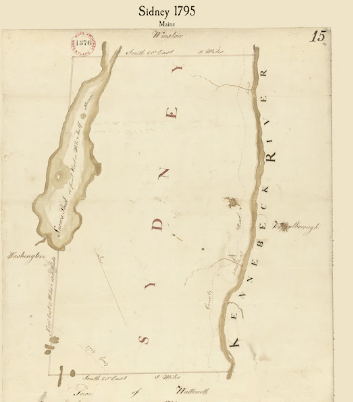 by Mary Grow
by Mary Grow
The town on the west bank of the Kennebec River south of Waterville that is now Sidney began as part of Vassalboro, the town on the east bank.
There seems to be unanimous agreement among historians that Sidney was incorporated as a separate town on Jan. 30, 1792, and that it was named after the British courtier, man of letters and soldier Sir Philip Sidney (1554-1586). (See box.)
The historians your writer found are equally unanimous in their silence on two topics: why Sidney separated from Vassalboro, and why the new town was named in honor of a 200-years-dead Englishman.
Two important sources your writer consulted are Alma Pierce Robbins’ 1971 history of Vassalboro and Alice Hammond’s 1992 history of Sidney. Both wrote about the Native Americans who lived along that stretch of the Kennebec and the Europeans who supplanted them.
Hammond, focused on the west bank of the river, repeated two legends about the Natives, one that indicated that swimming across Messalonskee Lake was a test of hardihood for young Natives, boys and girls alike.
Messalonskee Lake, aka Snow Pond, was once entirely in western Sidney and is now shared by Sidney and Belgrade, the next town west. It is more than eight miles long and makes up about the northern two-thirds of Sidney’s west boundary.
Hammond, again quoting the collector of legends, wrote that the name Messalonskee came from the Native word “muskalog,” or giant pike (still known as a muskellunge or muskie). Wikipedia says the alternate name Snow Pond recognizes Philip Snow, a settler there in 1774.
(Another important wet area is the Great Sidney Bog, in the southern end of town. In William D. Williamson’s 1832 History of the District of Maine, he wrote that Sidney covered 20,000 acres, “of which 1,000 is a bog.”
(Hammond, in 1992, said the bog covered 640 acres, two-thirds in Sidney and the rest in Augusta. An on-line State of Maine website calls the bog an area of statewide ecological significance, a 605-acre example of a Raised Level Bog.)
In her Vassalboro history, Robbins gave the 1761 survey by Nathan Winslow as the Kennebec Proprietors’ action that spurred settlement on the Vassalboro section of the Kennebec. Early family names she mentioned include Bacon, Faught, Lovejoy and Marsh.
“The land transactions in Vassalboro were in the beginning more active on the west side of the river,” Robbins wrote. One reason she gave was the streams that flowed into the Kennebec from the west and were dammed to provide water power for sawmills and grist mills.
Henry Kingsbury, in his Kennebec County history, gave a second reason, Sidney’s “superior attractions for settlement.”
“After inspecting the adjacent sections on either side, an observer must have been agreeably impressed, then as now, with its comparatively level surface and the infrequency of rugged hills and still more rugged rocks,” he wrote.
For the prospective farmer, he continued, “The soil on the eastern half, that borders the river, is very favorable for cultivation and the production of grain and grass, but not as well adapted to fruit trees as the western half, in which apples are a staple crop.”
He also praised the “variety and enormous growth” of the forests, which kept mills busy “for more than half a century”; and recognized the value of the river as a transportation artery for farm and forest products.
After Vassalboro was incorporated on April 26, 1771, Robbins wrote that the first town meeting was held May 22, 1771, at James Bacon’s. She described him as “physician and innkeeper.” He is referred to in various sources as Dr. James Bacon and as James H. Bacon; your writer thinks these references are all to the same man.
Robbins did not say on which side of the Kennebec James Bacon had his tavern. Michael Denis, in his extensive Bacon genealogy, says it was on the west – Sidney – side; and your writer has found supporting evidence.
Dr. James Bacon was born June 30, 1738, in Billerica, Massachusetts. On Sept. 23, 1764, in Hallowell, he married Abigail Marsh, born in Menden, Massachusetts, Nov. 24, 1747. Her father, John Marsh, had come to what would become Sidney in 1760; in 1763, Denis wrote, Bacon received a land grant in future Sidney.
Between 1767 and 1790, Familysearch says, the James Bacons had seven daughters and three sons (other sources list fewer children). They named their oldest daughter, who was born in 1767 and died in 1812, Abigail. Her birthplace is given as Kennebec, Maine, and she married a Vassalboro man in 1786.
The oldest son was James Josiah Bacon, born in 1770 and died in 1834. Familysearch says he was born in Vassalboro and married a Vassalboro woman in 1791.
At least four of James and Abigail’s children were born in Sidney, according to Familysearch. They were Sarah B., born in 1775 (and died in Sidney); Lydia, born in 1781 (and died in Sidney); William Marsh, born Sept. 22, 1782 (and was married and died in Sidney); and Ebenezer, born in 1788. Hannah, born in Maine about 1778, died in Sidney (Find a Grave has a photo of her gravestone in Sidney’s Field Cemetery; it says she died June 11, 1867, age 89).
James Bacon’s older brother, Ebenezer Bacon, was definitely a Sidney resident. Robbins cited a July 14, 1773, deed to him from the Kennebec Proprietors for 500 acres “lying on the West side of the Kennebec River.”
Ebenezer Bacon was born in Bedford, Massachusetts, on Sept. 15, 1736, and married Abigail Farwell (1734-1817), in Boston, in 1762. She was the widow of Levi Richardson, whom she had married in Woburn, Massachusetts, in 1753.
Ebenezer and Abigail had at least two daughters and two sons, born between Jan. 1, 1763 and Aug. 23, 1770; Familysearch says all four were born in Sidney. The older boy was Ebenezer Bacon Jr., born in 1765; the younger girl, born in 1770, was Abigail.
The senior Ebenezer died Feb. 12, 1798, in Sidney. Abigail died in Vassalboro in September 1817.
Robbins summarized what she considered major actions at that first Vassalboro town meeting in 1771, and at following ones. Among decisions pertinent to Sidney were a spring 1773 vote to provide “a burying ground on each side of the river”; and a November 1773 decision to build a meeting house on the “west side of the river.”
In 1786, she wrote, without further explanation: “Talk of separating the Town by the river began, the east side to keep the incorporation.” A few paragraphs later, Robbins wrote, “In 1793 the accounts between the Towns of Sidney and Vassalborough were adjusted, and Vassalborough became the east side of the Kennebec River.”
When Alice Hammond took up the story of Sidney as a separate town, she described the 1761 survey by Nathan Winslow that laid out three tiers of lots on either shore of the Kennebec. In 1774, she continued, John Jones surveyed two more tiers west of the original three, “completing the survey from the Kennebec River west to Lake Messalonskee.”
Between the two surveys was a narrow strip, called a gore (many Maine towns had gores). The gore, too, was divided into lots. Hammond wrote that one of its six sections, including five of its 56 lots, was named the Bacon Tract .
Hammond found copies of land deeds from the 1770s at the Kennebec Registry of Deeds in Augusta. She listed some of the early Sidney landowners as Dr. James Bacon, Ebenezer Bacon, Abiel (alternately spelled Abial in the early documents she cited) Lovejoy, and John Marsh.
She then reprinted a Feb. 26, 1892, Kennebec Journal article listing early Sidney settlers, in recognition of the town’s 100th anniversary.
This list includes William Bacon (Sept. 22, 1782 – Oct. 15, 1852), James and Abigail’s son. The newspaper writer said:
“Mr. Bacon kept a tavern in the house that sits where Carlos Hammond now [1892] lives and it is said used to dispense ‘New England rum’ at a ‘four pence ha’penny’ a glass. It was from him that Bacon’s Corner takes its name.”
An on-line map shows Bacon’s Corner in south central Sidney, west of Interstate 95, the four-way intersection of Dinsmore and Shepherd roads with Middle Road.
Sidney’s first town meeting, Hammond said, was called by Abial Lovejoy, constable, at David Smiley’s. Smiley she described as an “inn keeper on the River Road,” the closest to the Kennebec of several north-south roads through Sidney.
Hammond did not date the first meeting, but it was early in 1792, because the second one was in May of that year, she said. Voters at that meeting chose a four-man committee to settle accounts with Vassalboro.
Hammond said nothing more about the committee, but apparently its work succeeded, since Robbins was able to report that the towns’ accounts were settled in 1793.
Sir Philip Sidney
Wikipedia’s long article on Sir Philip Sidney calls him a “poet, courtier, scholar and soldier who is remembered as one of the most prominent figures of the Elizabethan age.”
He was born Nov. 30, 1554, at Penshurst Place, a still-standing medieval castle 32 miles southwest of London. The house, built in 1341, had been in the family since 1552, when King Edward VI granted it to Sidney’s grandfather.
Sidney was the oldest of at least three children. Educated at Christ Church, part of Oxford University, he went on his first diplomatic mission at age 18, one of a delegation that failed to arrange a marriage between Queen Elizabeth and a son of the French King Henry II.
(Readers may remember that Elizabeth I, who reigned from 1558 to 1603, was known as “the virgin queen” – she never did marry.)
After three years in Europe, Sidney returned to England where, Wikipedia says, he occupied himself with “politics and art,” including terms in Parliament in the 1580s. Simultaneously he was active in the military, fighting for the Protestant cause in Ireland in 1575 and 1576 and in the Netherlands in 1585 and 1586.
His literary works included a collection of poems, a romance and a critical work on poetry. The Wikipedia writer considered the last two influential in the subsequent development of English literature.
Queen Elizabeth knighted Sidney in 1583. The same year, he married Frances Walshingham, 16-year-old daughter of the Queen’s principal secretary; they named their daughter, born in 1585, Elizabeth.
On Sept. 22, 1586, Sidney was wounded at the Battle of Zutphen in the Netherlands, where English troops were supporting Dutch Protestants against Spanish Catholics. He died of gangrene on Oct. 17, aged 31.
Main sources
Denis, Michael J., Families of Oakland, Maine December 2023 found on line.
Hammond, Alice, History of Sidney Maine 1792-1992 (1992).
Kingsbury, Henry D., ed., Illustrated History of Kennebec County Maine 1625-1892 (1892).
Robbins, Alma Pierce, History of Vassalborough Maine 1771 1971 n.d. (1971).
Websites, miscellaneous.
EVENTS: Sidney Masons to hold annual pig roast
/0 Comments/in Events, Sidney/by Website Editor The Ancient Free and Accepted Masons invite the public to their third annual “Pig Roast”. Last year’s event was met with such enthusiasm; they decided to repeat this year. Rural Lodge #53, of Sidney, was established in 1827 and has always maintained a strong community presence.
The Ancient Free and Accepted Masons invite the public to their third annual “Pig Roast”. Last year’s event was met with such enthusiasm; they decided to repeat this year. Rural Lodge #53, of Sidney, was established in 1827 and has always maintained a strong community presence.
For those of you who are not familiar with the Masons, they are a Service to Mankind Organization, located at 3000 Middle Road, Sidney. They do such projects as Bikes for Books, giving away as many as 18 bikes per year. They also raise funds for Project Graduation for a local high school, mandating no alcohol or drugs. They are also very active in a food drive for the Sidney Food Pantry. They also do what is caledl the Handy Brigade which gives assistance to the elderly and our veterans in need. They try to be a beacon of charity and good will in the community.
They are inviting one and all on Sunday, August 4, from 11 a.m. – 4 p.m., to enjoy a wonderful time and meal with them and perhaps some of your friends. It’s a great opportunity to get out and perhaps make new friends. The fare is all homemade and delicious. The course includes Rotisserie Pig, potato and macaroni salads, dinner rolls, Cole slaw and various drinks, cake.
The fee for this humanitarian fare is $12 for adults and $6 for children. So bring a smile and an empty stomach and enjoy the experience. This cause is great as mentioned above and you will leave with a full belly and a full heart. If you are on the run they can do TO-GO plates for your convenience. Thank you to sponsors Fanado Pelotte Construction, O’Connor Auto Park, Gary Allen, Dogg House Restaurant, Cony Hannaford, of Augusta, and the The Town Line newspaper.
This event will be in honor of recently deceased great Worshipful Wayne Ireland.
Area students named to dean’s honor list at Cedarville University
/0 Comments/in Chelsea, China, School News, Sidney/by Website Editor The following area students at Cedarville University, in Cedarville, Ohio, have been named to the dean’s honor list for the Spring 2024 semester:
The following area students at Cedarville University, in Cedarville, Ohio, have been named to the dean’s honor list for the Spring 2024 semester:
Catherine Estes, of Sidney, Josette Gilman, of China, and Rebecca Riley, of Chelsea.
SNHU announces winter 2024 honors
/0 Comments/in Anson, Augusta, Fairfield, Jefferson, Madison, Oakland, School News, Sidney, Waterville, Winslow/by Website Editor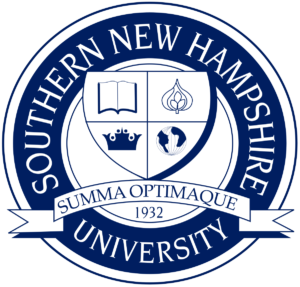 Southern New Hampshire University (SNHU), in Manchester, New Hampshire, announces the following students being named to the Winter 2024 President’s List.
Southern New Hampshire University (SNHU), in Manchester, New Hampshire, announces the following students being named to the Winter 2024 President’s List.